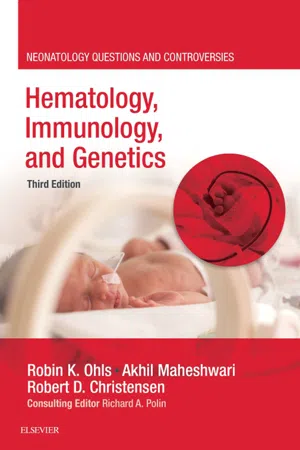
Hematology, Immunology and Infectious Disease
Neonatology Questions and Controversies
- 345 pages
- English
- ePUB (mobile friendly)
- Available on iOS & Android
Hematology, Immunology and Infectious Disease
Neonatology Questions and Controversies
About this book
Dr. Richard Polin's Neonatology Questions and Controversies series highlights the most challenging aspects of neonatal care, offering trustworthy guidance on up-to-date diagnostic and treatment options in the field. In each volume, renowned experts address the clinical problems of greatest concern to today's practitioners, helping you handle difficult practice issues and provide optimal, evidence-based care to every patient.- Stay fully up to date in this fast-changing field with Hematology, Immunology and Genetics, 3rd Edition.- The most current clinical information, including new coverage of exome sequencing, properties of donor milk, necrotizing enterocolitis and nutrition, thrombocytopenia in neonates with necrotizing enterocolitis, early diagnosis of severe combined immunodeficiency, and newborn screening.- New content on the genetic basis for neonatal disorders, new strategies for genetic diagnosis (such as whole exome sequencing and microarrays), antenatal genetic testing, and ethical dilemmas and genetic counselling.- Current coverage of using new complete blood count (CBC) parameters to help guide neonatal care, neonatal neuroprotection, and differentiating hemolytic from non-hemolytic neonatal jaundice.- Consistent chapter organization to help you find information quickly and easily.- The most authoritative advice available from world-class neonatologists who share their knowledge of new trends and developments in neonatal care.- Expert Consult™ eBook version included with purchase. This enhanced eBook experience allows you to search all of the text, figures, and references from the book on a variety of devices. Purchase each volume individually, or get the entire 7-volume set, which includes online access that allows you to search across all titles!Gastroenterology and NutritionHematology, Immunology and GeneticsHemodynamics and CardiologyInfectious Disease and Pharmacology New Volume!Nephrology and Fluid/Electrolyte PhysiologyNeurologyThe Newborn Lung
Frequently asked questions
- Essential is ideal for learners and professionals who enjoy exploring a wide range of subjects. Access the Essential Library with 800,000+ trusted titles and best-sellers across business, personal growth, and the humanities. Includes unlimited reading time and Standard Read Aloud voice.
- Complete: Perfect for advanced learners and researchers needing full, unrestricted access. Unlock 1.4M+ books across hundreds of subjects, including academic and specialized titles. The Complete Plan also includes advanced features like Premium Read Aloud and Research Assistant.
Please note we cannot support devices running on iOS 13 and Android 7 or earlier. Learn more about using the app.
Information
Stem Cell Therapy in Neonates—the Time Has (Almost) Come
Stem cells: important in development and disease
- 1. Potency, describing the ability to form cells of a single cell line (unipotent) up to all cell lines of an organism (pluripotent).
- 2. Self-renewal potential, describing the ability to preserve a stem cell pool by asymmetric or symmetric cell division.
Mesenchymal stromal cells: orchestrator of immune response and healing processes
- 1. Adherence to plastic
- 2. Positivity for the cell surface markers CD73, CD105, and CD90
- 3. Absence of CD45, CD34, CD14/CD11b, CD79a/CD19, and HLA-DR
- 4. In vitro differentiation into chondroblasts, osteoblasts, and adipocytes
Endothelial colony-forming cells: when angiogenesis counts

Amnion epithelial cells—don’t discount the placenta
Bronchopulmonary dysplasia and stem cell therapy
Table of contents
- Cover image
- Title page
- Table of Contents
- Series Editor
- Copyright
- Contributors
- Series Foreword
- Preface
- Chapter 1. Stem Cell Therapy in Neonates—the Time Has (Almost) Come
- Chapter 2. Genome and Exome Sequencing: Can It Impact Clinical Care in the Neonatal Intensive Care Unit?
- Chapter 3. Transfusion Thresholds in the Neonatal Intensive Care Unit: What Have Recent Randomized Controlled Trials Taught Us?
- Chapter 4. Donor Milk Compared with Mother’s Own Milk
- Chapter 5. Will Standardized Approaches to Nutrition Decrease Necrotizing Enterocolitis?
- Chapter 6. Nonimmune Neonatal Hemolytic Anemia: Recent Advances in Diagnosis and Treatment
- Chapter 7. Using the New Complete Blood Count Parameters in Neonatal Intensive Care Unit Practice
- Chapter 8. How Near Are We to Using Darbepoetin or Erythropoietin as Neuroprotective Agents for Perinatal Hypoxic-Ischemic Encephalopathy?
- Chapter 9. How Do We Adopt Anemia-Preventing Strategies in Our Delivery Rooms?
- Chapter 10. Thrombocytopenia in Infants with Necrotizing Enterocolitis
- Chapter 11. Genetic Basis of Necrotizing Enterocolitis
- Chapter 12. Genetic Basis of Patent Ductus Arteriosus
- Chapter 13. Genetic Basis of Bronchopulmonary Dysplasia
- Chapter 14. Prenatal Genetic Testing
- Chapter 15. Early Diagnosis of Severe Combined Immunodeficiency
- Chapter 16. Newborn Screening
- Index